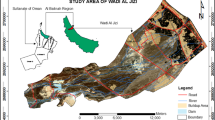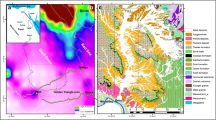Abstract
Mapping of geological, topographical, and hydrological elements is critical for understanding and assessing the regional hydrological setting in an arid region. In this study, a synergistic approach has been developed, which uses a combination of remote sensing data and geographic information system (GIS) to map factors controlling groundwater recharge, discharge, and quality across the Abu Dhabi Emirate. The Spectral Angel Mapper (SAM) algorithm, which uses a n-D angle to match the pixels to reference spectra, was used to map new water-bearing rocks, and the deterministic eight-node (D8) algorithm, which allows flow to only one of the eight neighbors based on the direction of steepest descent, was used to map paleochannels. The terrain category was applied to simulate seawater intrusion from digital elevation model (DEM). New maps of lithology, normalized difference vegetation index (NDVI), and paleochannels were derived and interpreted from multi-sources of remote sensing data. The study indicated that the area was produced by a fluvial and eolian process and recharged by local, intermediate, and regional flows. The results showed that the Oman and Hafeet Mountains are the natural sources of groundwater recharge as well as HCO3, Ca, Na, and Mg in groundwater. The mapped factors were spatially correlated with hydrologic anomalies observed in groundwater wells. The integrated approach is timely, cost-effective, and can be used in arid regions for numerical modeling as well as water balance analysis.









Similar content being viewed by others
References
Al-Rashed MF, Sherif MM (2000) Water resources in the GCC countries: an overview. Water Resour Manag 14(1):59–75
Alsharhan AS, Rizk ZA, Nairn AE, Bakhit DW, Alhajari SA (2001) Hydrogeology of an arid region: the Arabian gulf and adjoining areas. Elsevier B.V, The Netherlands, p P.331
Brook MC and Dawoud M (2005) Coastal Water Resources Management in the Coastal Zones of United Arab Emirates. Symposium on Integrated Coastal Zone Management, Abu Dhabi, UAE
Brook M, Al Houqani C, Darawsha T, Al Alawneh M, Achary S (2006) Groundwater Resources; Development and Management in Abu Dhabi Emirate, UAE. In Proceedings of 3rd Joint UAE-Japan Symposium, Sustainable GCC Environment and Water Resources, EWR, 2006
Cartwright I, Weaver TR, Fulton S, Nichol C, Reid M, Cheng X (2004) Hydrogeochemical and isotopic constraints on the origins of dryland salinity, Murray basin, Victoria, Australia. Appl Geochem 19:1233–1254
Dehaan RL, Taylor GR (2002) Field-derived spectra of salinized soils and vegetation as indicators of irrigation-induced soil salinization. Remote Sens Environ 80:406–417
Elmahdy SI and Mohamed MM (2012a) Influence of geological structures on groundwater accumulation and groundwater salinity in Masandam Peninsula, UAE and Oman, Geocarto International, DOI:10.1080/10106049.2012.724455
Elmahdy SI, Mohamed MM (2012b) Topographic attributes control groundwater flow and groundwater salinity of Al Ain UAE: a prediction method using remote sensing and GIS. J Environ Earth Sci 2(8):1–13
Elmahdy SI, Mohamed MM (2012c) Geological lineament detection, characterization and association with groundwater contamination in carbonate rocks of musandam peninsular using digital elevation model (DEM). Open Hydrol J 6(Suppl 1-M3):45–51
Elmahdy SI, Mohamed MM (2013a) Natural hazards susceptibility mapping in Kuala Lumpur, Malaysia: an assessment using remote sensing and geographic information system (GIS). Geomatics Nat Hazards Risk 4(1):71
Elmahdy SI, Mohamed MM (2013b) Remote sensing and GIS applications of surface and near-surface hydromorphological features in Darfur region, Sudan. Int J Remote Sens 34(13):4715–4735
Elmahdy SI, Mohamed MM (2014a) Relationship between geological structures and groundwater flow and groundwater salinity in Al Jaaw Plain, United Arab Emirates; mapping and analysis by means of remote sensing and GIS. Arab J Geosci 7(3):1249–1259
Elmahdy SI, Mohamed MM (2014b) Probabilistic frequency ratio model for groundwater potential mapping in Al Jaww plain UAE. Arab J Geosci 15:1–12
Elmahdy SI, & Mohamed MM (2014c) Automatic detection of near surface geological and hydrological features and investigating their influence on groundwater accumulation and salinity in southwest Egypt using remote sensing and GIS. Geocarto International, (ahead-of-print), 1-13
Elmahdy SI, Mohamed M (2014d) Groundwater potential modelling using remote sensing and GIS: a case study of the Al Dhaid area United Arab Emirates. Geocarto Int 29:433–450
Elmahdy SI, Mansor S, Rodsi A, Bujang BK (2011) Geotechnical modeling of fractures and cavities that are associated with geotechnical engineering problems in Kuala Lumpur limestone, Malaysia. Environ Earth Sci 62(1):61–68
Elmahdy SI, Mansor S, Huat BB, Mahmod AR (2012) Structural geologic control with the limestone bedrock associated with piling problems using remote sensing and GIS: a modified geomorphological method. Environ Earth Sci 66(8):2185–2195
Freeze RA, Cherry JA (1979) Groundwater. Prentice-Hall, Englewood Cliffs, 604p
GuthPL (2009) Geomorphometry in MICRODEM. In: T. Hengl and H.I. Reuter, eds. Geomorphometry: concepts, software, applications [online]. Developments in soil science series. USA Navy Academy, 351–366. Available from: http://www.usna.edu/Users/ oceano/pguth/website/microdemdown [Accessed 13 September 2012]
Hoffmann J (2005) The future of satellite remote sensing in hydrogeology. Hydrogeol J 13:247–250
Hounslow AW (1995) Water quality data analysis and interpretation. CRC Press Inc Lewis Publishers, New York, 397p
Hutchinson CB (Ed.) (1996) Ground-water resources of Abu Dhabi Emirate, U.S. Geological Survey Administrative Report prepared for the National Drilling Company of Abu Dhabi, P.135
HydroConsult (1987) Reconnaissance Report and Development Proposals, Abu Dhabi, (UAE) Eastern Region Water Resources,” Ministry of Petroleum and Mineral Resources Report, Government of Abu Dhabi, UAE, 126 p
JICA (Japanese International Cooperation Agency) (1996) The master plan study on the groundwater resources development for agriculture in the vicinity of Al Dhaid in the UAE, JICA International Cooperation Agency, (1996), Final Report
Jenson SK, Domingue JO (1988) Extracting topographic structure from digital elevation data for geographic information system analysis. Photogramm Eng Remote Sens 54(11):1593–1600
Kruse FA, Lefkoff AB, Boardman JB, Heidebrecht K, BShapiro AT, Barloon PJ, Goetz AFH (1993) The spectral image processing system (SIPS) - interactive visualization and analysis of imaging spectrometer data. Remote Sens Environ 44:145–163
Leblanc M, Razack M, Dagorne D, Mofor L, Jones C (2003) Application of meteosat thermal data to map soil infiltrability in the central part of the lake Chad basin, africa. Geophys Res Lett 30(19):1998. doi:10.1029/2003GL018094
Maged MM (2014) Particle Swarm Optimization for Geological Feature Detection from Palsar Data.Proceeding of 35th Asian Conference on Remote Sensing will be held at Nay Pyi Taw, Myanmar from 27- 31, October 2014
Marghany M (2012) Fuzzy B-spline algorithm for 3-D lineamentreconstruction. Int J Phys Sci 7(15):2294–2301
Marghany M, Mansor S, Hashim M (2009) Geologic mapping of united arab emirates using multispectral remotely sensed data. Am J Eng Appl Sci 2:476–480
Metternicht G, Zinck JA (1997) Spatial discrimination of salt-and sodium-affected soil surfaces. Int J Remote Sens 18(12):2571–2586
Mohamed M, Almualla A (2010) Water demand forecasting in Umm Al-Quwain using the constant rate model. Desalination 259:161–186
Mohamed MM, Elmahdy SI (2014) Natural and anthropogenic factors affecting groundwater quality in the eastern region of the United Arab Emirates. Arab J Geosci 12:1–15
Mohamed MM, Hatfield K (2005) Modeling microbial-mediated reduction in batch reactors. Chemosphere 59(8):1207–1217
Mohamed M, Hatfield K (2011) Dimensionless Monod parameters to summarize the influence of microbial inhibition on the attenuation of groundwater contaminants. Biodegradation 22:877–896
Mohamed M, Hatfield K, Perminova IV (2007) Evaluation of Monod kinetic parameters in the subsurface using moment analysis: theory and numerical testing. Adv Water Resour 30(9):2034–2050
Mohamed M, Hatfield K, Hassan AE, Klammler H (2009) Stochastic evaluation of subsurface contaminant discharges under physical, chemical, and biological heterogeneities. Adv Water Resour 33(7):801–2010
Mohamed MMA, Saleh NE, Sherif MM (2010a) Modeling in situ benzene bioremediation in the contaminated Liwa aquifer (UAE) using the slow-release oxygen source technique. Environ Earth Sci 61(7):1385–1399
Mohamed M, Saleh N, Sherif M (2010b) Sensitivity of natural attenuation to variations in kinetic and transport parameters. Bull Environ Contam Toxicol 84(4):443–449
Paillou PH, Schuster M, Tooth S, Farr T, Rosenqvist A, Lopez S, Malezieux MJ (2009) Mapping of a major paleodrainage system in eastern Libya using orbital imaging radar: The Kufrah River. Earth Planet Sci Lett 277(2009):327–333
Salama R, Tapley I, Ishii T, Hawkes G (1994) Identification of areas of recharge and discharge using Landsat-TM satellite imagery and aerial photography mapping techniques. J Hydrol 162:119–141
Sherif MM, Mohamed MM, Shetty A, Almulla M (2010) Rainfall-runoff modeling of three wadis in the northern area of UAE. J Hydrol Eng 16(1):10–20
Shirazi SM, Imran HM, Akib S (2012) GIS-based DRASTIC method for groundwater vulnerability assessment: a review. J Risk Res 15(8):991–1011
Shirazi SM, Imran HM, Akib S, Yusop Z, Harun ZB (2013) Groundwater vulnerability assessment in the Melaka state of Malaysia using DRASTIC and GIS techniques. Environ Earth Sci 70(5):2293–2304
Subba RN (2006) Groundwater potential index in a crystalline terrain using remote sensing data. Environ Geol 50:1067–1076. doi:10.1007/s00254-006-0280-7
Tang C, Machid I, Shindo S, Kondoh A, Sakura Y (2001) Chemical and isotopic methods for confirming the roles of wadis in regional groundwater recharge in a regional arid environment: a case study in Al Ain, UAE hydrological processes hydrology. Process 15:2195–2202
UAE National Atlas (United Arab Emirates National Atlas) (1993) Remote sensing center: UAE University, p. 188
US Geological Survey (2001) Bibliography of National Drilling Company – United States Geological Survey Reports on the Water Resources of Abu Dhabi Emirate. U.S Geological Survey Open File Report 2001-XXX
Wood WW, Sanford WE (2002) Hydrogeology and solute chemistry of the coastal – sabkha aquifer in the emirate of Abu Dhabi. In: Joerg Barth H, Benno B (eds) Sabkha ecosystem, Vol 1- the sabkhas of the Arabian peninsula and adjacent countries. Kluwer Academic Publishers, Dordrecht
Woodward GL, Al Sharhan AS (1994) Domlomitization and chertification of the early Eocene Rus formation in Abu Dhabi UAE. Sediment Geol 91:273–285
Acknowledgments
This research was funded by the UAE National Water Center (NWC) and the UAE University Program for Advanced Research (UPAR) (projects’ numbers NWC -3-2013- 31R008 and UPAR-7-2013-31N166). The authors acknowledge the assistance provided by both institutes.
Author information
Authors and Affiliations
Corresponding author
Rights and permissions
About this article
Cite this article
Elmahdy, S.I., Mohamed, M.M. Groundwater of Abu Dhabi Emirate: a regional assessment by means of remote sensing and geographic information system. Arab J Geosci 8, 11279–11292 (2015). https://doi.org/10.1007/s12517-015-1932-2
Received:
Accepted:
Published:
Issue Date:
DOI: https://doi.org/10.1007/s12517-015-1932-2




